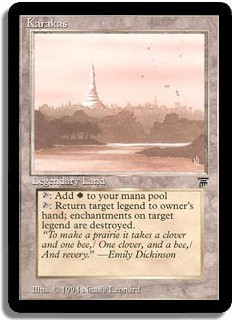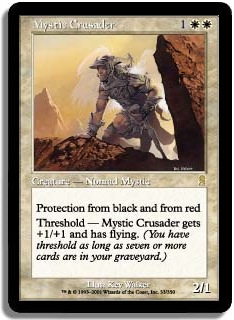One of the most important concepts to understand when designing and maintaining a cube is the concept of Opportunity Cost. If you fell asleep during Econ 101, here’s what it is in a simplified
form.
“The loss of potential gain from other alternatives when one alternative is chosen.”
Well, that didn’t help much.
In plain English, the concept states that when someone does something, it is at the cost of not being able to do something else, due to the fact that
people have inherently limited resources (time, money, and space are all finite).For example, by reading this article, you’re not just doing it at the cost of using your time— but at the cost of doing something else, like playtesting.
So what does this have to do with cube?
Karakas is essentially an upgraded basic Plains. It’s vulnerable to nonbasic land hate like Wasteland and Goblin Ruinblaster, but aside from the cases
where your opponent has those kinds of cards, Karakas is an upgrade to the ol’ basic Plains. There are plenty of legendary creatures in cube, and
Karakas is useful against ones like Akroma, Angel of Wrath and Braids, Cabal Minion, and with ones like Vendilion Clique and Venser, Shaper Savant.
Since all white decks use Plains and the drawback to using Karakas in the place of Wasteland is minimal (as there are few nonbasic land hate cards in
cube), using Karakas in a cube should be pretty easy to do, since it’ll be used in just about every white deck, right? Well, not really, and that’s
because of the opportunity cost of running it in the first place.
In a Constructed format, using Karakas instead of a basic Plains doesn’t require taking opportunity cost into effect. If I were to use Karakas in a
Constructed deck, I’d have to consider the drawback of its being a nonbasic land (which is especially huge a factor in Legacy where Wastelands are
everywhere), but opportunity cost wouldn’t be a factor, since using Karakas in the place of a basic Plains doesn’t mean that I can’t use other cards
for other slots—a change of Plains into Karakas is pretty easy. This isn’t the case in cube, where there are a finite number of card slots available.
If you have a cube that puts color-aligned lands such as Karakas in its aligned color section (like using Karakas in a white section), despite the fact
that Karakas will be used in nearly every white deck, it comes at a cost—being in your white section instead of other cards. It’s a good idea to have
an “on-deck” binder (cards that are in consideration for being in your cube), and by using Karakas in a white section, it’s fighting for the same slot
as the other white cards in your on-deck binder (which in my cube include very good cards like Mystic Crusader and Karmic Guide that I just don’t have
room for).
While Karakas will make more final 40s than the latter two cards or even cards that are presently in my white section, the ultimate question remains:
Does Karakas help white decks in my cube more than other white cards in my cube or my on-deck binder? Even if a card like Pianna, Nomad Captain ends up
in a sideboard (since a white drafter may end up going into control), its overall benefit to white decks is still stronger than that of Karakas,
since Pianna is a stronger overall card, despite the upsides on Karakas, as its use is relatively limited in the grand scheme of things.
If you’re considering not using Mystic Crusader or Pianna, Nomad Captain in the place of Karakas, it’s important to note that while Karakas is a “safe”
inclusion for a white section, as every white deck will use Karakas, its overall lowered power level doesn’t help white as a whole perform better than
the cards that are being considered for replacement. Even though something like Karakas is a safe white card, it’s being used at the cost of
other, better cards.
But what if you’re using Karakas in something like a color-aligned land cycle with cards like Treetop Village, Volrath’s Stronghold, Faerie Conclave,
and Barbarian Ring? In this case, even though Karakas is being used as part of a cycle, it’s still being used at the cost of using other lands
that make white better, like Kjeldoran Outpost and Kor Haven. While both cards have drawbacks in mana production (Outpost requiring a Plains sacrifice,
Kor Haven producing colorless mana), the overall effect of both of those lands is still stronger than that of Karakas. In this case as well, using
Karakas isn’t free because using it keeps better cards like Kjeldoran Outpost and Kor Haven out.
Using Karakas in a land section without other cards to balance it doesn’t really result in Opportunity Cost, but it does make things a little less
balanced. Granted, running a miser’s Karakas isn’t going to make a cube go completely out of whack balance-wise, but it’s generally good to have each
section balanced (in function), and every little bit helps when it comes to balancing a cube.
Gitaxian Probe
 {PU}
Sorcery        (c)
{PU} can be paid with either U or 2 life.
Look at target player’s hand.
Draw a card.
Gitaxian Probe is another card that can easily be used in decks—it has a cheap casting cost, and its alternate cost allows it to be cycled for no mana.
It provides an effect that combines nicely with blue counterspells, allowing a blue mage to see if a spell that’s on the stack is a true threat or just
a test spell. It combines nicely with discard spells like Duress and Thoughtseize, preventing whiffs on those spells.
However, despite the fact that it can be cast very cheaply (usually without mana) and thus may end up making final 40s of blue decks, a color like blue
is especially stacked, and competition for blue slots is very competitive. It’s very safe to use Gitaxian Probe, but is it worth the opportunity cost
of using something better that may not make as many final 40s? For the same reason that I’m not using Karakas, I’m not using Gitaxian Probe; these
cards don’t bring enough to the table for those colors.
A card like Borderland Ranger in a medium-sized cube list (360-540 cards) works in the same way; it’s a very safe card that I wouldn’t feel ashamed to
use in green-based midrange, control, and even aggro decks. The reason that I don’t use it is that even though it’s a safe card and will likely be used
in many decks (although not as easily as cards like Karakas), it doesn’t bring as much to the table as other, more powerful cards that I’m running instead do, but if my list was on the larger side, I’d run it.
However, I’m more than happy to use it in my commons cube because the power level is lower!
These cards won’t be picked as highly as less safe cards in the same colors because those free cards don’t bring as much to the table as more powerful
ones.
Safe cards aren’t the only place where opportunity cost arises. Let’s look at one of the creatures from New Phyrexia.
Vault Skirge
{1}{PB}
Artifact Creature — Imp
({PB} can be paid with either {B} or 2 life.)
Flying, lifelink
1/1
I find that, generally, cubes don’t support aggressive strategies enough to make them a relevant and winning strategy (I’ll go more into detail on that
in another article!). Some of this lack of support stems from the fact that people have been taught to almost never use one-drop creatures in Limited
decks due to their minimal impact on the battlefield.
Granted, there are exceptions to this rule. Consider the following common one-mana all-stars in normal Limited environments:
Many of these creatures were excellent Limited cards. Cards like Intimidator Initiate, Shadow Guildmage, and Goldmeadow Harrier were able to repeatedly
disable opposing creatures, making their presence relevant through the entire game, and cards like Wild Nacatl and Steppe Lynx remained relevant in a
game because of the 2+ power. While merely saying “this card was good in Limited, so it’s good in cube” isn’t right, realizing why those cards were
powerful is important—they have a lasting impact on the game and are worth the slot in their decks.
The problem with creatures that only have one power and that don’t have a very board-altering effect is that they don’t really affect the battlefield
very much. Cards like Suntail Hawk and Nip Gwyllion do have abilities in addition to their bodies and can attack for several points of damage, but
their bodies eventually reach the point where their size becomes irrelevant, making it so that they are not worth using because of their minimal board
impact.
Cube one-drops generally need to be in two camps to be cubeworthy:
They must either have 2+ power (without a horrible drawback), helping to provide aggressive decks with the necessary critical mass of creatures like
Wild Dogs, Kird Ape (in addition to other early aggressive creatures like Keldon Marauders), so that aggro archetypes can be healthily drafted and win
part of the cube metagame. Each aggressive creature has a powerful impact on the board since each one takes chunks out of an opposing player’s life
total quickly. While they aren’t as powerful on turn 8 as they are on turn 2, their 2+ power makes it so that they retain relevance (an aggro deck
should kill its opponent before the opponent can reach turn 8 anyway).
They must have abilities that have a lasting and relevant effect on the game—creatures like Spikeshot Elder and Mother of Runes act like the Limited
powerhouses listed above; they remain relevant as the game progresses. Mother of Runes taps to prevent your creatures from being Doom Bladed on turn 2
just as well as it does on turn 5.
Unfortunately, Vault Skirge falls into neither category and therefore doesn’t seem very cubeworthy.
Despite having two abilites, its overall effect is quite minimal on the battlefield. Much like the Suntail Hawks and Nip Gwyllions of Limited, Vault
Skirge doesn’t have a very big impact on the battlefield and doesn’t provide enough of an impact for its slot in a deck. I’m not merely saying that
Vault Skirge isn’t good enough, and that’s it, but more that the characteristics inherent in the card (being a 1/1 for one that doesn’t have a big
impact when it’s in play) make it not worth a deck slot. If it fails on the “doesn’t provide enough of an impact on the board” test, it definitely will
fail on the cube construction level! Unlike Borderland Ranger, however, Vault Skirge wouldn’t make the grade in my commons cube either because of its
innate characteristics (low board impact due to low power and toughness combined with its abilities). Â
When considering cards for your cube, it can be easy to include “safe” cards that can easily be used in decks, but it’s important to keep opportunity
cost in mind and to not just consider a card’s power when using a card but what’s not being used in its place.
May your P1P1s contain Sol Rings!
@UsmanTheRad
 on Twitter
My blog featuring my cube lists: http://idratherbecubing.wordpress.com
Cube podcast that I and Anthony Avitollo co-host: The Third Power



